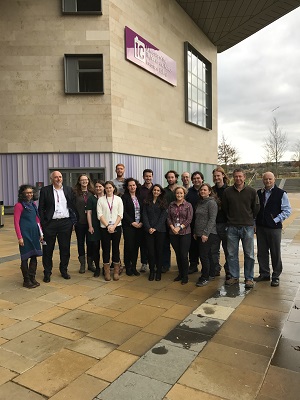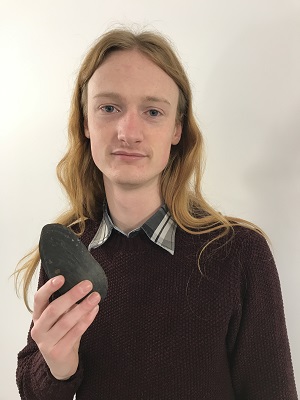Inverness College UHI research could aid conservation efforts
Inverness College UHI is expanding its research into the rapidly emerging field of environmental DNA (eDNA).
 Through a series of projects, University of the Highlands and Islands researchers based at Inverness College UHI are using the latest genomic technology to explore eDNA – DNA shed from organisms into the environment – and are developing new sampling techniques to test for the presence and abundance of species.
Through a series of projects, University of the Highlands and Islands researchers based at Inverness College UHI are using the latest genomic technology to explore eDNA – DNA shed from organisms into the environment – and are developing new sampling techniques to test for the presence and abundance of species.
This fast expanding area of research at Inverness College UHI has been boosted by the recruitment of its highest number of postgraduate research students yet.
The research is experimental, but if successful, the techniques could prove ground-breaking in environmental conservation and resilience management.
Inverness College UHI has an established and growing research expertise in key areas including freshwater biodiversity, ecology, forestry, literature and psychology.
Dr Melanie Smith, Head of Research Development at Inverness College UHI, said: “The use of eDNA is an emerging, but hugely exciting field for researchers interested in the environment and its conservation.
“Using state-of-the-art genomic technology, we’re working on a number of projects which are exploring the best methodology and technique for collecting eDNA and processing it. The potential is far-reaching and if we can use eDNA to identify the presence of an organism in the environment and then use that information to work out its abundance, it will be hugely valuable.
“This kind of analysis could revolutionise conservation and resilience management and save precious time and money by providing accurate information about what’s going on in our eco-systems, allowing conservationists to respond quickly to new additions, invasive species and conservational threats. It will provide an early detection system and check on the effectiveness of eradication programmes and could replace natural monitoring altogether.”
Researchers at the Inverness College UHI Rivers and Lochs Institute (RLI), which specialises in molecular genetics research, are currently using eDNA to assess the distribution, abundance and reproductive behaviour of Scotland’s endangered freshwater pearl mussels to aid in conservation efforts. The species is currently under threat from illegal pearl fishing, habitat change and poor water quality.
eDNA technology at Inverness College UHI is also being explored to detect and monitor slender naiad, an aquatic plant protected by EU law; to screen for invasive American signal crayfish in Scotland; and to understand the increasing numbers of non-native pink ‘humpback’ salmon in Scottish rivers and across Western Europe and advise on the threat to native Atlantic salmon.
In other projects, the RLI is collaborating with the Scottish Association of Marine Science (SAMS) UHI, also part of the University of the Highlands and Islands, Marine Harvest and the Scottish Environmental Protection Agency (SEPA) to evaluate the effectiveness of eDNA in the assessment of environmental impacts from salmon farming operations. The institute is also a partner in an EU collaboration known as the Horizon 2020 Scheme, developing an eDNA tool for the assessment of all vertebrate species in European rivers, which will be used to advise on the use of rivers barriers.
The number of postgraduate research students studying with the University of the Highlands and Islands at Inverness College UHI has increased year on year and in October it recruited five new students, bringing the number based at Inverness Campus to nine – the highest number to date. In total, there are 14 postgraduate research students based in Inverness including five Masters of Research students.
Dr Smith continued: “Students want to come to the University of the Highlands and Islands to do their PhDs because of the expertise we have in key areas and the state-of-the-art research environment we’ve created. Our genetics laboratory contains equipment to process DNA, hardly used anywhere else in the UK, while our work around freshwater biodiversity is ground-breaking. Through Scotland’s only School of Forestry, we’ve developed close links with industry and created an established platform of research excellence in this field which is unrivalled.”
Inverness College UHI also supports its teaching staff to pursue research in their field of interest, recognising the benefit it has for staff, students and the curriculum. It promotes opportunities across further and higher education, helping to create a more rounded, informative curriculum, which supports all students to become inquisitive thinkers.
“Research is at the heart of our vision for Inverness College UHI and by embedding it in all areas of the curriculum, right though from our SVQ and NC courses to HNCs, HNDs, Degrees, we not only create a more interesting and informative curriculum, where students learn about current developments in their area of study first-hand, we encourage and inspire the rights skills for the future and hopefully inspire more students to go on and pursue their own research interests,” Dr Smith continued.
To find out more about research at Inverness College UHI and the opportunities available, visit www.inverness.uhi.ac.uk/research
Case Studies

Sam Jones
Sam Jones (24) started his PhD with the University of the Highlands and Islands at Inverness College UHI in October. He studied Biology at York University before working for Natural England, the Environment Agency and North York Moors National Park, where he was involved in a freshwater pearl mussel and salmon recovery project.
Freshwater pearl mussels are an endangered species heavily threatened by illegal pearl fishing. More live in Scottish rivers than anywhere else in the world. The use of fertilisers and pesticides and excess silt/sediment in the river are also known to harm their survival and reproduction. Funded by the European Social Development Fund and the Scottish Development Fund, Sam is developing environmental DNA (eDNA) technology and methodology, which could be used to assess the distribution of freshwater pearl mussels and hopefully provide information on their abundance and reproductive behaviour. This technology would allow conservationists to identify populations, allowing them to focus efforts and investigate population health.
Jenny O’Dell
 University of the Highlands and Islands PhD student Jenny O’Dell joined Inverness College UHI in September. As well as designing cutting edge eDNA techniques for pearl mussel monitoring, Jenny is also investigating the genetics behind the pearl mussel life cycle and how they adapt to their environment. Freshwater pearl mussels reproduce parasitically, by releasing young which attach themselves to the gills of fish before dropping off and growing into adults. Jenny is keen to find out if there are genetic reasons why some prefer salmon and others prefer trout and if this information could aid in conservation.
University of the Highlands and Islands PhD student Jenny O’Dell joined Inverness College UHI in September. As well as designing cutting edge eDNA techniques for pearl mussel monitoring, Jenny is also investigating the genetics behind the pearl mussel life cycle and how they adapt to their environment. Freshwater pearl mussels reproduce parasitically, by releasing young which attach themselves to the gills of fish before dropping off and growing into adults. Jenny is keen to find out if there are genetic reasons why some prefer salmon and others prefer trout and if this information could aid in conservation.
Jenny studied Biological Sciences at Edinburgh University before going on to work for the Roslin Institute as a research assistant, investigating chicken genetics and their resistance to disease. She’s also worked for a number of healthcare biotech companies, including a start-up looking to use genomics to improve human cancer diagnostics.
Nick Crutchley
Nick Crutchley (47) is a University of the Highlands and Islands Masters by Research student based at Inverness College UHI. Nick taught business and economics before his interest in conservation and global warming drew him to do a Masters in Ecology and Conservation at Staffordshire University. There, he discovered the potential for eDNA in plant research but also his aptitude for research.
Nick’s Masters by Research, funded by Scottish Natural Heritage (SHN), is developing eDNA techniques to detect the presence of slender naiad (Najas flexilis) – an aquatic plant, protected under EU law. An important food source and indicator of biodiversity, it is under threat in Europe because of eutrophication (enrichment of a water body with nutrients) and acidification. SNH currently monitors and surveys the slender naiad by using divers, who swim down and record the plant’s habitat, presence and abundance. Nick is investigating whether eDNA can be used instead of traditional survey methods, or as a complement to provide a more rounded snapshot of ecosystems. By focussing on lochs in South/North Uist — each displaying different levels of eutrophication, acidification and abundance — Nick has discovered a technique to successfully extract eDNA from lochs to detect the presence of slender naiad and is currently refining the process to make it as robust as possible, and to provide recommendations on the best ways for collecting, preserving and processing samples.
Nick is due to finish his Masters by Research in May.